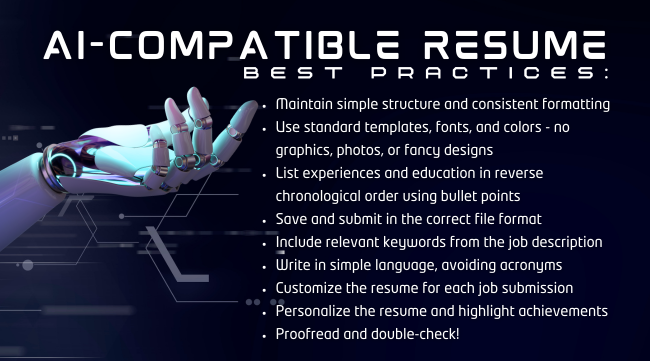
Artificial intelligence (AI) has revolutionized business operations in many ways, most notably human resources and recruiting functions. Workable’s 2024 AI in Hiring and Work Survey revealed that over 60% of participating companies had used AI in hiring within the past year, and about 80% predicted an increase in future usage.
Augmenting recruitment with AI undoubtedly has its array of business benefits, but for candidates who are struggling to get their resume in front of human eyes, applying through AI-powered portals presents more challenges than benefits. Job seekers, don’t panic! We’ve compiled some tips to help you construct an AI-compatible resume and improve your chances of landing an interview.
Structure and Formatting
1. Keep your resume simply structured and consistently formatted throughout the entire document. Include clear section titles to help AI recognize and categorize the information:
- Name and contact information
- Summary/heading
- Skills
- Work Experience
- Education
2. Including your name and contact information may seem like a no-brainer, but you’d be surprised how many resumes are sent without this vital information. Be sure to put this information in the body of the resume and not in the header or footer. Depending on the AI technology, information in these areas may not be recognized.
3. Stick with traditional resume formats/templates. You may feel inclined to create a highly designed resume to really showcase your creative and tech skills and stand out from other resumes, but AI will most likely have difficulty interpreting that type of resume.
- Stick with standard fonts, i.e., Arial, Calibri, Times New Roman, Helvetica, etc.
- Use a font size no smaller than 10pt and no bigger than 12pt
- Keep color to a minimum, either black, dark gray, or deep blue
- Avoid images or graphics and minimize fancy designs
- Many AI technologies view documents in plain text, so be sure to view your resume in this format before submitting it to make sure the content and format are acceptable. If you’re not sure how to convert a document to plain text, use this guide.
4. According to HipCV, “ATSs require information to be in chronological sequence to interpret it appropriately.” List experiences and education in reverse chronological order so the technology reads your experience as intended.
5. Save and submit your resume in the correct file format. Some ATSs will require a file upload as either a PDF or DOC/DOCX. Be sure to check which file formats are required before submitting.
Content
1. Read each job description thoroughly to identify critical keywords and integrate them into your resume. AI’s job is to do the first screen of the resume by matching keywords between job descriptions and resumes, so including the specific keywords, as they are written in the job description, will prompt the bot to flag a match. Just remember to only include keywords that are true to your experience and capabilities. Falsifying your resume is never a good idea!
2. Use bullet points and write short, clear, and concise sentences to describe your responsibilities in each role. The more clear and “to the point” you write your experiences, the easier it will be for the technology to comprehend.
3. Write in simple language and avoid corporate jargon or acronyms. While a hiring manager or recruiter may easily decipher that language, AI unfortunately cannot.
4. Personalize your resume content and highlight your achievements. You’re structuring your resume for AI, but after that, it’s read by a human. The tone of your resume should be professional, personal, and organic.
5. Customize your resume for each job you apply to. At first, this may be frustrating and take more time, but time spent on tailoring your resume to each job is going to benefit you more than sending one version to tens or hundreds of jobs.
6. Double-check your resume before you submit it! Writing an AI-compatible resume is a delicate balancing act. It must be readable by AI and humans. Run your resume through an online resume scanner to make sure it’s compatible with AI, and have another human proofread it to make sure it’s written in the right tone and doesn’t have typos or grammatical errors.

Navigating AI-powered recruitment systems can be challenging, but with the right approach, job seekers can improve the chances of their resume landing on a hiring manager’s desk. By structuring your resume clearly, using appropriate content, and tailoring each application, you can create a resume that is AI-friendly and compelling to human recruiters. Remember, the goal is to strike a balance between technology and your unique, personal touch. With a well-crafted, AI-compatible resume, you’ll be well on your way to landing an interview.
For more resume and job search tips, subscribe to The JOHNLEONARD Blog!
